November 30, 2004
Did someone say The Cardigans?
You’re from Sweden, so you know the Cardigans? That must be the most common question I get in Japan. To get an idea of Japanese people’s view of Swedish music I had a brief look around in music stores in central Tokyo. This is what I found.
In the pop/rock section in a major music store: Ana (Spiderman2 soundtrack), Mando Diao (rock from the 60’s in 2004), Sugarplum Fairy (copy of Mando Diao but younger), Last Days of April (cool, slow rock), The Sounds (argh, don’t like them) and of course The Cardigans (but just their old albums, strange).
In the worldmusic section I found Lisa Ekdahl (jazz, sing-songwriter), Svante Thuresson (jazz), Stina Nordenstam (hm, what genre?) and a CD with the title “Tittis bästa” (whatever that might be). So whether you’re Japanese or Swedish, what is your opinion on the selection above?
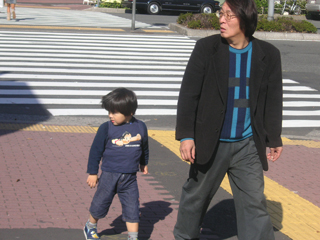
The Cardigans?
November 29, 2004
Peaceful Sunday
Another beautiful fall weekend just passed. I went for a walk with my friend Nana and took lots of pictures around Tokyo station and the Imperial Palace Garden. It was sunny (which made me happy as a little kid - after all I’m Swedish and Swedish people are crazy about the sun and the light in general).
The same day Nana and I visited a tempel in Gotanda to transcribe Buddhist scrips, the sutra called "Han-nya Shingyo". It was my first time writing in Japanese as well as using a Japanese calligraphy brush. The ceremony started out by eating a clove (kryddnejlika) to purify oneself, and yes, it was refreshing but spicy. I had to pass an elephant and sit down by a small table with a piece of thin paper in front of me. There were the ingredients to make my own ink and I spend one and a half hour writing Japanese signs in total silence. It was relaxing and really peaceful.
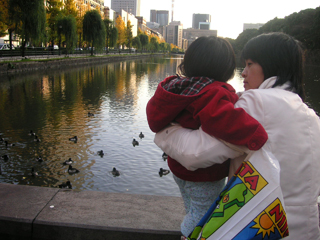
November 26, 2004
Celebrities rule on TV
The majority of Japanese ads and commercials are still using stereotypic gender roles, just like lots of other countries. Most girls are young and beautiful. The men are either old and successful or young and handsome. The most common commercials are for; candy/chocolate, skin and hair products, electronic equipment, noodles, coffe, beer and dieting pills/drinks.
The housewife complains about her chapped hands after washing the dishes. The Suica ad tells you the advantage of using a chargeable commuting pass – a slim wallet which makes your butt look smaller…
The use of celebrities in Japanese ads and commercials seems to be a must. Westerner actors and singers are commonly used in advertising but the majorities are famous Japanese and Korean people.
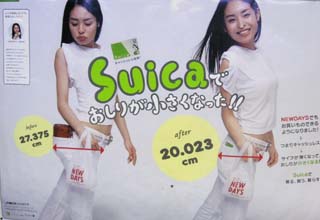
November 25, 2004
Kitchen disclosures
There sure is something in the saying that people with nice kitchens can’t cook. It’s like they try to cover it up with stylish design but in reality they just eat fast food or make coffee in there.
My roommate Ai (she will get a proper blog story later on), is great at cooking. So is our kitchen tiny (see picture), and consists of a small sink, a hotplate, a small fridge and a rice cooker. That’s it. No glazed tiles, matching kitchen ware or stainless steel items.
I live in a small apartment in Sweden just like here in Tokyo (sharing 36 m2 in Sweden vs. 24 m2 in Tokyo). I want my kitchen to be simple and easy to use. Every Japanese home I’ve visited has been small and the food delicious, except for one (my friend Nana has a big and brand new kitchen, but she doesn’t cook at all...). See what mean? It’s a world wide phenomenon… and yes, I’m a great chef! ;)

PS. Nana you'll get your own blog story too... don't worry. And even though you don't cook you're excellent at picking restaurants - see that's a great skill! :)
November 24, 2004
Spoiled dogs
Lots of dogs this week… Yesterday I went to a dog cafe in Ebisu. I’ve never heard about such a place before and I was curious to see what it was like. They had menus for both dogs and "humans"; the food looked the same but contained different ingredients (hopefully). A long-haired black dachshund in a striped shirt and a jeans jacket had a piece of cheesecake on the floor close to my chair.
The café had a small bath tub where you could wash your dog’s paws before lunch or dinner. There were hooks on the wall for bad dogs to be leached to but good dogs could walk around without their leach and sniff around in the café.
I’m not a dog owner myself (I’m actually pretty scared of dogs), but the café visit was a fun experience. It made me realize that to some people dogs must mean everything, that’s why they are willing to spoil them like crazy.
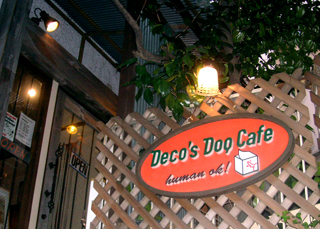
November 22, 2004
Not for the impatient shopper
Shopping in Tokyo is both heaven and hell. The city offers unlimited shopping possibilities like generous opening hours and countless stores. The bad thing is just – it’s too much! If you know what you’re looking for, let’s say a pair of jeans, you can spend a whole day just trying on different pairs without finding what you’re looking for or the right size. It makes me tired.
On the other hand, a city like Tokyo has a lot of small, funny and totally unnecessary stores. I found a dog store the other day with clothes in all sizes, fabrics and colors for your beloved pet. The people on the picture are actually looking straight into that shop… you’re getting curious huh?
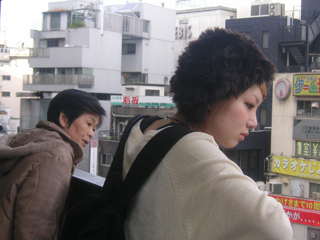
November 19, 2004
An illustrator's heaven
My main reason for this trip to Tokyo was to be surrounded and hopefully inspired by Japanese graphic design and illustrations. I take pictures every day and document a lot of commercials, advertisements and printed matters and try to grasp what makes it good or bad or just typical Japanese.
I really like that illustrations are used more frequently in Japan compared to Sweden. In grocery stores you see pictures of jumping mushrooms, happy squids and singing monkeys on packages and containers. In Sweden you see a photo of a strawberry on the yoghurt carton, sometimes there are drawn pictures but those products are “strictly” for KIDS ONLY! In that sense, Japan is heaven for people like me who are crazy about illustrated items.
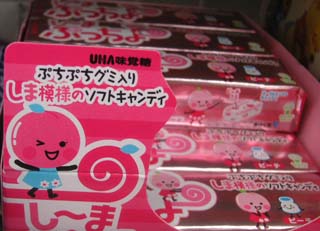
November 18, 2004
Everyday characters
Now and then I recognize people on my way to work. There’s the girl with the eggplant colored glasses, always wearing something admirable, and I remind myself that some day I’ll ask her where she goes shopping.
The cat man has a small lottery booth by the train station. You never see him talking to anyone but for his shabby cats, usually three of them, occupying the small windowsill of the lottery booth.
I really like the bike guards, don’t ask me why. They are cheerful old men in grey overalls and green caps taking care of peoples' bikes. In Japan you might get a parking fine if you park your bike were it’s not allowed. Every bike has a number and is registered at the local police office, so you can’t really get away with it…
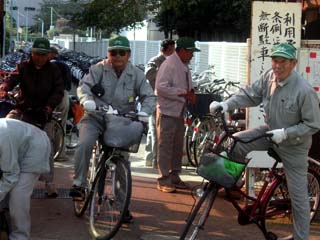
November 17, 2004
This girl sure likes mikan
Fruits are, just like public transportation, some of the most expensive everyday costs in Tokyo. You can get a net of mikan (tangerins) or a kaki (sharon fruit) pretty cheap in a supermarket but it’s worse when it comes to apples and other fruits. When I passed a nice fruit and vegetable store in Shin-Koiwa this morning they had 600 Yen apples on a stand (28 SEK) and two melons for 4500 Yen (290 SEK), now that is shocking.
Japan is a small country but still overpopulated and is therefore not self-sufficient when it comes to vegetables, fruits and meat just to mention some products. Imported food is of course more expensive and the fact that Tokyo is a capital makes it even more expensive for the costumers. And I know what you’re thinking – that girl sure likes mikan!
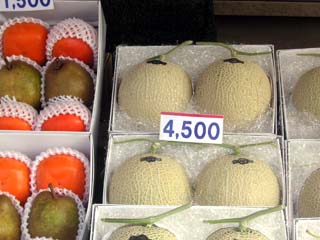
November 16, 2004
Art and design fever
Just like any other major city Tokyo offers are wide selection of art and design exhibitions. I appointed this week to be my cultural week starting today with an exhibition at the Swedish Embassy. With the slogan “slaughter a sweater - make a bag!” the Do Redo team shows handmade clothes, hats, mittens, shoes, and bags made of recycled sweaters. The purpose of the exhibition is to show how easy and interesting knitting can be and to encourage ordinary people to create new designs out of old clothes. Swe. info Eng. info Jap. info
Unfortunately I missed out on Design Festa which was held last weekend. Design Festa is a freestyle International Art Event open to all creators, both professional and non-professional from all over the world to exhibit their creative talent (check out their cool website!).
But there are more interesting exhibitions ahead like; Maria Testino “Portraits”, Wolfgang Tillmans "Fleischwimmer", Yayoi Kusama "Eternity - Modernity" and lots of others. I can't wait to see them!
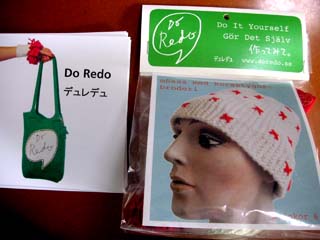
November 15, 2004
Children are the best teachers
Sooo cute! I’m talking about Japanese kids. Whenever I see a little one I get all excited and want to hug him or her, but at the last minute I control myself and usually I just take pictures of them, to the mothers’ happiness (who doesn’t want a cute baby that people want to take pictures of?).
I had the pleasure of hanging out with a co-workers 1,5 year old daughter last week. What a sweetie! She kept on saying “kore hana” (=this flower) and pointed at her pink dress. Children are the best teachers when it comes to learning a new language. So if I was smart enough I should spend an hour every day at a Japanese kindergarten… Oh well, enough of fantasies, I have to get back to work. Enjoy this sweetie I met in Asakusa last weekend.
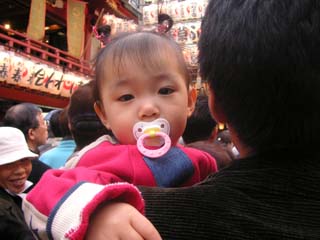
November 12, 2004
Tokyo traffic
The streets of Tokyo are full of mini trucks with a storage capacity of ten shoeboxes or less. They look funny but I’m sure they must be really convenient compared to the bigger ones. Some are very creative and colorful, others are plain white.
In Tokyo you drive on the left side of the street. The traffic is busy, but not too bad for being a city with millions of citizens. The parking is incredibly expensive in central Tokyo and since the local transportations are extremely effective people tend to not have cars. It’s basically too expensive and its actually more convenient using trains, busses and metro.
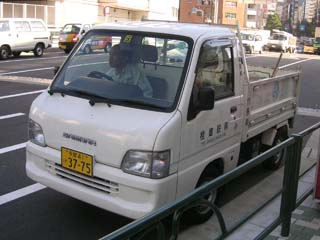
November 11, 2004
Keeping your butt warm
Japanese people seem very concerned about their toilets and the try their best to make them as comfortable as possible. I don’t know why, but it has probably to do with their love for hi-tech things in general and the fact that houses are usually pretty bad isolated and it gets cold indoors.
I have experienced two common toilets, one is covered with terry (frotté) – both toilet lid and ring, and the other one has a panel where you can switch on the heat, play a song and other necessary functions.
When it comes to public bathrooms, the Japanese are excellent. They are always clean and free of charge (in Sweden they are usually dirty and it costs 75-150 Yen to use them). So if you are cold and out of money in Japan – run for the bathroom!

* 11/11 Today is my mom's birthday - omedetoo haha! (=grattis mamma!)
November 10, 2004
Watch your feet
To visit a Japanese home is a true honor, but it can be difficult for a foreigner when it comes to “feet habits”. In a traditional Japanese house there are four different areas with four different “feet rules” so to speak. In a Japanese apartment there are usually just three areas. I’ll explain to you more closely.
When you enter a Japanese house you leave your shoes in the hall on “ground level”, you take a step up (but you’re still in the hall) and put on your slippers. If you enter a room with tatami mats (traditional straw mats) you must take of your slippers. When entering the bathroom you leave your slippers behind and put on a new pair just to be used in there. A regular Japanese apartment doesn’t have tatami mats, which makes it easier with just three different areas.
In Sweden it’s very simple. You take off your shoes at the door and let them stay there as long as you’re indoors. That’s why it was hard at first to adjust and take off my shoes or slippers several times while visiting a Japanese friend. In my apartment in Shin-Koiwa I made it simple and don’t wear slippers at all…
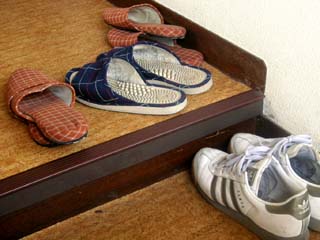
November 09, 2004
The country of ”kawaii”
Anyone could have a pink umbrella covered with rabbits in Japan, pretty much at least. The word “kawaii” (aww, so cute!) is used daily and covers everything that could possibly be adorable to someone. Disney toys hanging in big clusters from the schoolgirls’ bags, a dog wearing a small tight t-shirt, a pop idol with crooked teeth – they are all really kawaii.
In Sweden it’s rare with grownup people having kawaii things (even though my mom has a parade of soft little animals on her couch). This year there was actually a book published in Sweden called “Kawaii” about Japanese pop- and youth culture (läs den!)
But the dog on the picture is in fact not kawaii at all. Although I took lots of nice pictures of her (I assume it’s a female), she simply returned my favour by peeing on my bag.
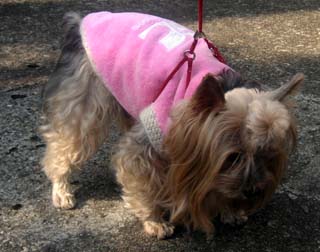
November 08, 2004
Yokohama in pastels
After a whole week in front of the computer I just had to get up and move. I love hiking and walking in general. This weekend I spend a whole day in Yokohama just walking along the sea with a friend. It was sunny with a beautiful light, the air was fresh and smelled of salt water. There were surprisingly few people out considering it was a Sunday. It was the total opposite of standing still in a humid train full of commuting people. In other words – lovely.
After the long walk we had some excellent dim sum (Chinese dumplings) in Yokohama’s Chinatown. Full of great food and a whole day outdoors made me ready for a new week at work, this time in Masuyama’s office.
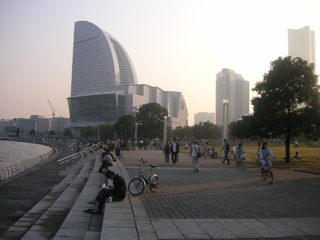
November 05, 2004
A complex city
The Tokyo Bay Area is not one huge city but four bigger cities steady growing together. It’s Yokohama, Tokyo, Chiba and Saitama. Of course you can divide these cities into even smaller cities, usually surrounding a metro or train station, but let’s just stay here this time.
It’s a very diverse city where old and new buildings climb on each other. There are clear contrasts, a tiny old wooden temple can be found next to a brand new and very tall office building. The city has a very complex net of highways, roads and rails crossing each other in different layers and stretches out in both horizontal and vertical directions. These constructions are very impressing; but how does it all fit together so well?

November 04, 2004
Great inspiration
My stay in Japan is most of all a great time for inspiration. Everyday habits change and you notice differences from your life back home. Japanese draining-wells are my latest obsession. They are so beautiful with different patterns, signs and graphic figures. I spent a few hours last weekend in Kawagoe just taking pictures of them. When other people take pictures of temples, shrines and gardens I look down to snap and immortalize these neglected treasures!
I wonder who made them, what they had in mind while designing them and what the different signs and symbols stand for. Will I ever find out?

November 02, 2004
You Should Look like everyone else...
What is up with all the YSL-bags (a.k.a. Yves Saint Laurent) in Tokyo? At the train today there were three women in a row next to me with brown bags in their laps. I see them everywhere, and I don’t understand what could possibly make them so special. Yes, they are expensive and yes, it’s a famous brand and most likely yes, you should look like everyone else. That’s my impression at least.
But luckily there are other trends and other opinions when it comes to fashion. Next to my work there’s a fashion college. The neighborhood is surrounded with young people uniquely dressed and styled (seen the book/magazine “Fruits”?). It makes me happy to see these creative and crazy fashion students and at the same time I can escape the brown bags.
CORRECTION: What I mean is Louis Vuitton - not YSL.
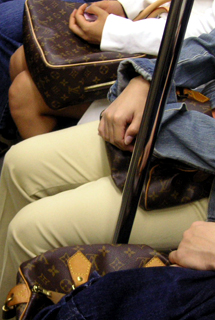
November 01, 2004
Cut it right
I didn’t realize squids were quite as big and slimy when I saw them in the store in Saitama this weekend. The one my friend bought was grey and smelly. Back at her house she taught me how to remove the guts, wash of the black liquid and finally how to cut it right. We made tempura (deep fried meat, fish and vegetables). It was delicious!
What amazes me about Japanese food and cooking is the patience. If you want fast food, you should go and get noodles or something, but when it comes to a real nice dinner it takes hours to prepare everything. If you make a salad every little carrot, radish and cucumber must be cut very thin and precise. I didn’t get it at first but now it makes sense. The nicer it looks the better meal.

